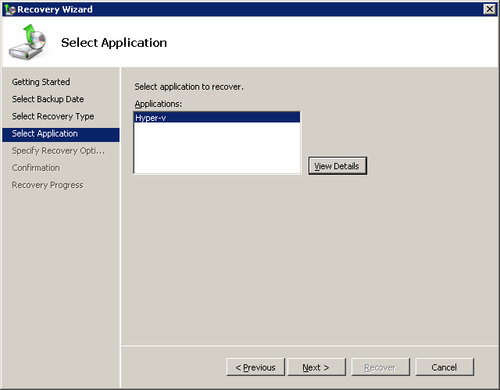5. Recovering Applications and Data
The Recovery Wizard in Windows Server Backup can be used to
recover applications and data from a backup, provided that the
application in question uses Volume Shadow Copy
Service (VSS) technology so that it is compatible with Windows
Server Backup. Also, the VSS writer for the application must have
been enabled before you created the backup being used for recovery.
Most applications do not enable the VSS writer by default. You will
have to explicitly enable it. If the VSS writer was not enabled for
the backup, you will not be able to recover applications from
it.
To recover an application, follow these steps:
Open the Administrative Tools menu, and click Windows
Server Backup.
In the Actions pane, under Windows Server Backup, click
Recover to start the Recovery Wizard.
On the Getting Started page, specify whether the
application will be recovered from backups run on this computer
or another computer and then click Next.
If you’re recovering local applications, the location of
the backup is already known. If you’re recovering an application
for a different server, you’ll be prompted for the location of
the backup files. Click Next.
On the Select Backup Date page, select the date and time
of the backup to restore from and click Next.
On the Select Recovery Type page, choose Applications and
then click Next.
On the Select Application page, under Applications, select
the application to recover, as shown in Figure 2.

If the backup that you are using is the most recent and
the application you are recovering supports a roll-forward of the
application database, you will see a check box labeled Do Not
Perform A Roll-Forward Recovery Of The Application Databases.
Select this check box if you want to prevent Windows Server
Backup from rolling forward the application database that is
currently on your server. Click Next.
Warning:
IMPORTANT
Roll-forward recovery uses information stored in transaction
log files to return a database to the state it was in at an
exact point in time. To perform a roll-forward recovery,
archival logging must be enabled and a full backup image of
the database must be available, as well as access to all
archived log files created since the last successful backup
image.
If a roll-forward recovery isn’t possible, a version
recovery will be performed. Version recovery is the process
used to return a database to the state it was in at the time a
particular backup image was made.
On the Specify Recovery Options page, select How Do You
Want To Recover The Application Data and then select one of the
following options:
Note:
If you recover to a different location, only the
application data will be recovered. The
application itself will not be recovered.
Click Next to open the Confirmation page, review the
details, and then click Recover to restore the listed
items.
On the Recovery progress page, view the status of the
recovery operation to determine whether it was completed
successfully.